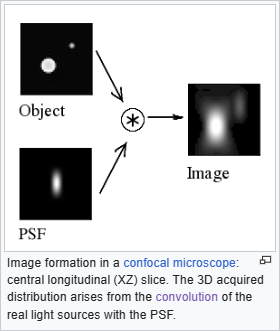|
Glossary |
PSF Point Spread Function |
updated: 2024-03-18 |
The point spread function (PSF) describes the response of a focused optical imaging system to a point source or point object. A more general term for the PSF is the system's impulse response; the PSF is the impulse response or impulse response function (IRF) of a focused optical imaging system. The PSF in many contexts can be thought of as the extended blob in an image that represents a single point object, that is considered as a spatial impulse. In functional terms, it is the spatial domain version (i.e., the inverse Fourier transform) of the optical transfer function (OTF) of an imaging system. It is a useful concept in Fourier optics, astronomical imaging, medical imaging, electron microscopy.

The degree of spreading (blurring) in the image of a point object for an imaging system is a measure of the quality of the imaging system. In non-coherent imaging systems, such as fluorescent microscopes, telescopes or optical microscopes, the image formation process is linear in the image intensity and described by a linear system theory. This means that when two objects A and B are imaged simultaneously by a non-coherent imaging system, the resulting image is equal to the sum of the independently imaged objects. In other words: the imaging of A is unaffected by the imaging of B and vice versa, owing to the non-interacting property of photons. In space-invariant systems, i.e. those in which the PSF is the same everywhere in the imaging space, the image of a complex object is then the convolution of that object and the PSF. The PSF can be derived from diffraction integrals.[1]
Reference: Point spread function - Wikipedia
Created with the Personal Edition of HelpNDoc: Powerful and User-Friendly Help Authoring Tool for Markdown Documents
